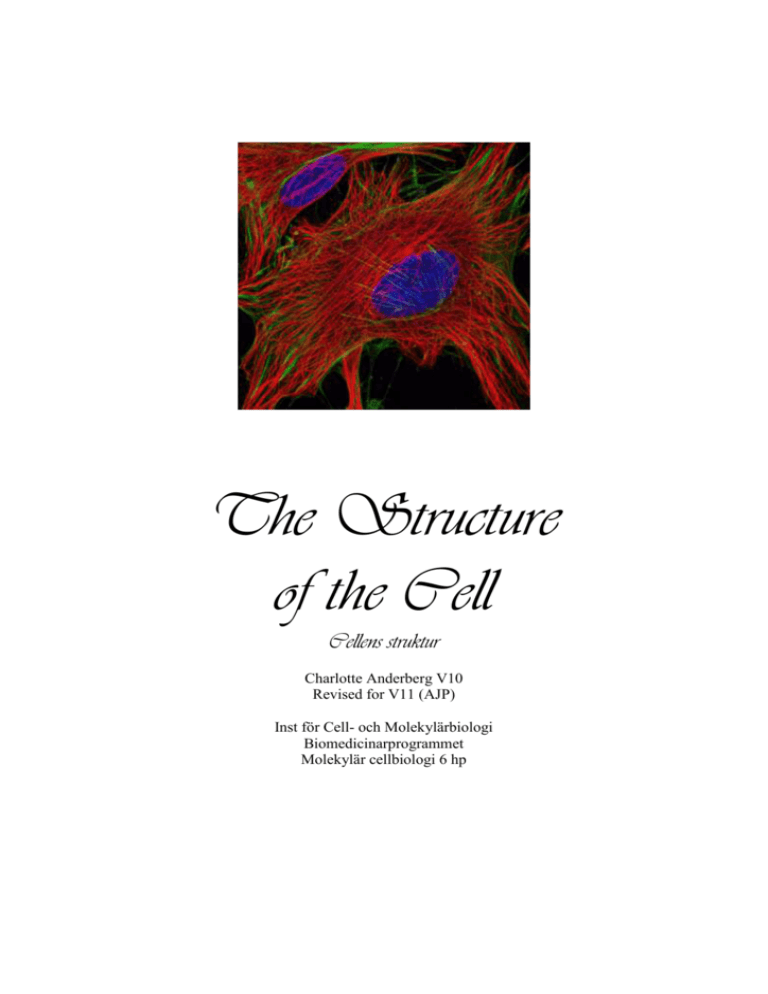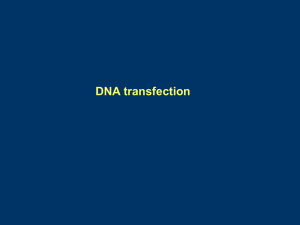Laboratory Practical in the Structure of the Cell
advertisement

The Structure of the Cell Cellens struktur Charlotte Anderberg V10 Revised for V11 (AJP) Inst för Cell- och Molekylärbiologi Biomedicinarprogrammet Molekylär cellbiologi 6 hp Table of content LABORATORY PRACTICAL: THE STRUCTURE OF THE CELL -------------------------------------- 3 AIMS OF PRACTICAL (SYFTE) -------------------------------------------------------------------------------------------- 3 GOALS OF PRACTICAL (MÅL) -------------------------------------------------------------------------------------------- 3 MATERIALS ---------------------------------------------------------------------------------------------------------------- 3 PROCEDURE ---------------------------------------------------------------------------------------------------------------- 3 EXAMINATION ------------------------------------------------------------------------------------------------------------- 3 INTRODUCTION TO PRACTICAL ------------------------------------------------------------------------------ 4 CELL CULTURES ----------------------------------------------------------------------------------------------------------- 4 LABELING ------------------------------------------------------------------------------------------------------------------ 4 MULTILABELING ---------------------------------------------------------------------------------------------------------- 5 FLOW SCHEME ------------------------------------------------------------------------------------------------------- 6 DETAILED PROTOCOLS ------------------------------------------------------------------------------------------- 7 TRANSFECTION OF PLASMIDS-------------------------------------------------------------------------------------------- 7 IMMUNOCYTOCHEMISTRY --------------------------------------------------------------------------------------------- 10 FLUORESCENCE MICROSCOPY ---------------------------------------------------------------------------------------- 13 APPENDIX ------------------------------------------------------------------------------------------------------------- 14 2 Laboratory Practical in the Structure of the Cell Aims of Practical (syfte) Introduce the student to the experimental analysis of the structure of the cell. Goals of Practical (mål) Transfection of eukaryotic cells. Use of fluorescent reporter molecules in cell biology. Microscopic analysis of specifically stained or tagged cell structures. Understand the possibilities, limitations and requirements of the methods used. Practical experience in the documentation of such experiments. Materials Human cell lines HeLa and U87 grown directly on cover slips in 6 well plates Plasmid coding for a GFP tagged protein localized to specific compartment in the cell. Primary antibody recognizing internal cell structure Alexa 488 (FITC) coupled secondary antibody Transfection reagent FuGene6 Phalloidin-TRITC (direct stain, actin) Vectashield mounting media with DAPI Light microscopes. Fluorescence microscopes. Low-resolution microscopes. Procedure The laboratory begins with transfection of cell cultures with plasmids coding for a GFP-tagged protein. The transfected cells are grown directly on prepared cover slips. The cells are fixed, stained, mounted and visualized with fluorescence microscopy. Immunocytochemical techniques will be used to label endogenous proteins. Cells are also grown directly on cover slips and will follow similar protocols to the previous. This will be performed in small groups of 2-3 students. Examination A short, max 2 pages Times New Roman size 12, laboratory report (per group) containing a short introduction, results and discussion. The main goal of this laboratory is to understand the methods: possibilities, limitations and requirements. In your report you should compare the methods for example regarding efficiency and specificity. There are questions that you should answer during the practical in the detailed protocol, make sure to include the answers in your report. 3 Due date: 2011-04-01, 16.00 Send by e-mail to: courses@cmb.ki.se For subject write CSL and group number. Name the report CSL followed by group number. Write your name and group number on every page. Introduction to Practical Cell Cultures An important component of modern cell biology is the use of cell culture techniques. Cells of different types can be separated from tissues and grown in the laboratory. Such cell cultures are for example used to study the many functions and structures of a cell. For these experiments two different human cell lines will be used, HeLa and U87. The cells used in the practical have been grown directly on microscope cover slips in 6-well cell culture dishes. The cover slip can be used as a suitable support for execution of the procedures as well as for microscopic visualization. Labeling Labeling with fluorophores enables us to visualize certain molecules. The problem is how to attach the fluorophores on structures or proteins that we want to study? Here we will be using three different methods to achieve this. 1. We can use a molecule that can bind directly to some structure or protein and is (or becomes) a fluorophore in itself. These are called direct stains. In this experiments we will be using DAPI that binds to DNA and Phalloidin that binds to actin. 2. We can couple a fluorophore to an antibody and let the antibody bind to a protein of interest. This is called immunolabeling and there are many variants to this technique. One very common feature to these techniques is to enhance the signal using a primary antibody that binds to the protein we want to study, and a secondary antibody coupled to the fluorophore. The secondary antibody recognizes the primary antibody. Since we will use this immunolabeling technique on cells, we then call it immunocytochemistry. We will use primary antibodies directed towards different intracellular structures and fluorescently labeled secondary antibodies. 4 3. The generation of fusion-proteins allows us to connect a fluorophore covalently to a protein of interest. This can be done with purified proteins, but is usually done at the DNA level. In this way we create a fusion-protein that is our normal protein of interest together with a fluorescent protein. The greatest advantage of this method is that you can study protein dynamics in living cells. The disadvantage is that you use exogenous proteins that aren’t normally in the cell. We will use Green Fluorescent Protein (GFP) coupled to different intracellular structures. Multilabeling But how can we look at different structures in the same cell? The easiest way is to use different fluorophores. If two fluorophores are excited by different wavelengths, we can change the dichroic mirrors (and some additional filters) so that we look at the different fluorophores one by one. Our microscopes have three different dichroic mirrors and filters settings: Blue: excitation 350-400 nm, emission 430-470 nm Green: excitation 470-490 nm, emission 510-530 nm Red: excitation 550-570 nm, emission 590-620 nm Where excitation means the wavelengths of light reaching the sample and emission the wavelengths that can reach our eyes. We’ll be looking at DNA with DAPI (blue), actin filaments with TRITC-Phalloidin (red) and intracellular structures with FITC (green) and with a Green Fluorescent Protein (GFP) fusion. Before you reach the microscopes, it is always good to plan what you will be seeing in the different cover slips and in which dichroic mirror/filter setting you will be seeing what… 5 Flow Scheme 6 Detailed Protocols This lab is divided in two parts that run in parallel. In the first part (Transfection) we will transfect HeLa cells and U87 with plasmids that encode for a GFP fusion protein localized to specific complartments in the cell. In the second part (Immunocytochemistry) we will stain proteins in HeLa cells and U87 using antibodies. In both cases we will also stain the actin cytoskeleton with a direct stain, phalloidin and the DNA with DAPI (Vectashield). You will not know what intracellular structure that will be stained using antibodies or fusion proteins, that is for you to figure out when you are looking in the microscope. The intracellular structures we have reagents to detect in this practical are: microtubuli, endoplasmatic reticulum (ER), mitochondria and the golgi apparatus. IMPORTANT: When working with cover slips, always remember which side the cells are on, so that you don’t scrape them away nor let them dry! Note that the experiments will be done with both cell lines in duplicates. There will be one plate for the transfection and one plate for the immunocytochemistry. Transfection of plasmids Remember which set of cells you’ve used for transfection. A good labeling system is a good idea to keep in mind. Day 1 To avoid contamination, this part of the protocol is done in a sterile environment. 1. Preparation of the Transfection Solution (for four wells) a. Pipette 400 µl of serum-free cell medium (DMEM) in to an eppendorf tube. b. Add 12 µL of FuGene6 to the medium. Take care not to let the FuGene touch the plastic walls of the tube. c. Let mix stand at room temperature for 5 min. d. Add 4 µg of pDNA (concentration see each tube) to the Transfection Solution. Mix gently. e. Let mix stand at room temperature for 15 min. 2. Observe the cells briefly in an inverted light microscope low-resolution microscope. Look for confluency (% of surface of the dish and cover slip covered with cells). 7 3. Change medium for transfection. a. Gently remove medium from the cells on the plate by pipetting (two wells per cell line). b. Replace with 2 mL of fresh medium (DMEM containing 10% heatinactivated fetal bovine serum, L-Glutamine and PenStrep (Penicillin Streptomycin)) pipetting slowly and against the side of the dish. 4. Transfection. a. Add ¼ of the total volume of the transfection solution (1.) to each well with cells. This should be done drop wise while swirling the plate. b. Place the cell plates back in the incubator. Properly identify your plates. Time of expression of the pDNA after transfection is dependent on strength of promoter and cell type, among other factors. A period of 48h is usually a good empirical time point for expression of most commonly used plasmids. Day 2 Avoid exposing the cell cultures for long periods of time to room temperature. Make sure you have an available inverted light microscope (low-resolution microscope) before taking the cells from the incubators. Briefly inspect the cells in the microscope. How are they growing on the plate and on the cover slip? How confluent are they today? What shape do they have (morphology)? Are there any signs of contaminations (alteration of the color of the medium, cloudiness and/or abnormal growth)? Day 3 Take note that formaldehyde is toxic by contact and inhalation. Work with gloves and in a fume hood or ventilated bench. Note also that DAPI and Phalloidin are toxic. Work with gloves. Try to minimize the time that you have the cells dry. This can produce artifacts and difficulties in the interpretation of the results. The cells are growing on cover slips. There will be a series of inverting the cover slips to expose the cells to the different labeling reagents. Therefore, try never to forget on which side of the cover slip the cells are (named top-side). Also keep in mind that they may loosen from the cover slip so be careful when adding liquids to the wells. 8 Remember that fluorophores are light sensitive molecules. The samples should be kept from exposure to direct light at all times when using the fluorophores, remember that you have transfected a fluorophore containing protein, as well as there after. Briefly inspect the cells in the microscope. 1. Gently remove medium from the transfected cells on the plate by pipetting. 2. Wash cell cultures in the wells three times with ice-cold PBS. 3. Add 1.5 mL Fixing Solution (4% Paraformaldehyde) to cover the cells. Let stand at room temperature for 20 min in the dark (covered with aluminum foil). This is to be done on a ventilated bench. 4. Wash three times with PBS (Phosphate Buffer Saline). 5. Add 1.5 mL Permeabilization Buffer (0.1% Triton-X 100 in PBS) to the cells to disrupt the cell membrane. Let stand at room temperature for 15 min in the dark (covered with aluminum foil). a. Create a humidifying chamber: Cut filter paper so that it covers the bottom of a well. Place it in a Petri dish and soak it with water. Pour off the excessive water. b. Place a piece of parafilm on the soaked filter paper. Add a drop (25 µL) of Direct Stains Solution (TRITC conjugated Phalloidin diluted 1:200 in 0.1% BSA in PBS) on the parafilm. Make sure to keep the solution in the dark. 6. Wash two times with 2 mL PBS and a third time with 2 mL 0.1% BSA in PBS for 5 min. 7. Pick up the cover slip with the cells using forceps (it is easier if the well contains some liquid so don’t remove the 0.1% BSA in PBS solution) and dry the back with a Kleenex (not the cells). Invert the cover slip on the drop of Direct Stains Solution so that the top-side is immersed in the solution. Let stand at room temperature in the dark for 30 min. Don’t forget to close the plate in order to form the humidifying Chamber. 8. Place the cover slip back in the well top-side up. Wash one time with 2 mL 0.1% BSA in PBS followed by two washes with 2 mL PBS. 9. Add a very small drop (about 5 L) of Vectashield fluorescence specialized mounting media containing DAPI to the middle of a microscopy slide. Don’t forget to properly label your slides. 10. Pick up the cover slips with forceps and dry the back of the cover slip with a Kleenex. Invert the cover slip top-side down on the mounting media drop. 11. Study the cells in the fluorescence microscope. 9 Immunocytochemistry Remember which set of cells you’ve used for transfection. A good labeling system is a good idea to keep in mind. Day 1 Take note that formaldehyde is toxic by contact and inhalation. Work with gloves and in a fume hood or ventilated bench. Try to minimize the time that you have the cells dry. This can produce artifacts and difficulties the interpretation of results. The cells are growing on cover slips. There will be a series of inverting the cover slips to expose the cells to the different labeling reagents. Therefore, try never to forget on which side of the cover slip the cells are (named top-side). Also keep in mind that they may loosen from the cover slip so be careful when adding liquids to the wells. 1. Observe the cells briefly in an inverted light microscope low-resolution microscope. Look for confluency (% of surface of the dish and cover slip covered with cells) 2. Gently remove medium from two wells of each cell line on the plate by pipetting. 3. Wash cell cultures in the wells three times with 2 mL ice-cold PBS (Phosphate Buffer Saline). 4. Add 1.5 mL Fixing Solution (4% Paraformaldehyde) to cover the cells. Let stand at room temperature for 20 min. This is to be done on a ventilated bench. 5. Wash three times with 2 mL PBS. 6. Add 1.5 mL Permeabilization Buffer (0.1% Triton-X 100 in PBS) to the cells to disrupt the cell membrane. Let stand at room temperature for 15 min. 7. Wash three times with 2 mL PBS. 8. Add 1.5 mL Blocking Solution (0.1% Tween-20 with 1 % BSA in PBS) to the cells. This is to block unspecific binding of the antibody. Let stand at room temperature for 30min. a. Create a humidifying chamber: Cut filter paper so that it covers the bottom of a Petri dish. Place it in a well and soak it with water. Pour off the excessive water. 10 b. Place a piece of parafilm on the soaked filter paper. Add a drop (25 µL) of Primary Antibody Solution diluted 1:200 in Blocking solution (0.1% Tween-20 with 1% BSA in PBS) on the parafilm. 9. Pick up the cover slip with the cells using forceps (it is easier if the well contains some liquid so don’t remove the 0.1% Tween-20 with 1% BSA in PBS solution) and dry the back with a Kleenex (not the cells). Invert the cover slip on the drop of Primary Antibody Solution so that the top-side is immersed in the solution. Do not forget to close the plate in order to form the humidifying chamber. Place in the fridge. For longer periods the incubation with the antibodies is preformed at 4ºC, so we use the fridge. Otherwise, it could be incubated for one to two hours at room temperature. Day 3 Note that DAPI and Phalloidin are toxic. Work with gloves. Try to minimize the time that you have the cells dry. This can produce artifacts and difficulties in the interpretation of the results. The cells are growing on cover slips. There will be a series of inverting the cover slips to expose the cells to the different labeling reagents. Therefore, try never to forget on which side of the cover slip the cells are (named top-side). Also keep in mind that they may loosen from the cover slip so be careful when adding liquids to the wells. Remember that fluorophores are light sensitive molecules. The samples should be kept from exposure to direct light when using the fluorophores as well as there after. 1. Observe the cells briefly in an inverted light microscope low-resolution microscope. Look for confluency (% of surface of the dish and cover slip covered with cells). 2. Place the cover slip back, top-side up, in one of the empty wells of the cell plate. Wash three times with 2 mL Washing Solution (0.1% Tween-20 in PBS). a. Remove the parafilm with the Primary Antibody Solution from the humidifying chamber. b. Place a new piece of parafilm and add a drop (25 µL) of Secondary Antibody Solution (appropriate FITC conjugated antibody) and TRITC conjugated Phalloidin (both diluted 1:200 in Blocking solution (0.1% Tween-20 with 1% BSA in PBS). 3. Pick the cover slip with the cells and dry the back with a Kleenex (not the cells). Invert the cover slip on the drop of Secondary Antibody Solution so that the top-side is immersed in the solution. Let stand at room temperature in the dark for 30 min. Do not forget to close the Petri dish in order to form a humidifying chamber 11 4. Place the cover slip back in the well top-side up. Wash four times for 5 min with 2 mL Washing Solution (0.1% Tween-20 in PBS). 5. Add a very small drop (about 5 L) of Vectashield fluorescence specialized mounting media containing DAPI to the middle of a microscopy slide. Don’t forget to properly label your slides. 6. Pick up the cover slips with forceps and dry the back of the cover slip with a Kleenex. Invert the cover slip top-side down on the mounting media drop. 7. Study the cells in the fluorescence microscope. 12 Fluorescence Microscopy Don’t forget to label your slides properly. Additionally, try to understand which settings of the microscope you will need to use in order to visualize each of the stainings. The microscopes that we will be using have three different channels (filter and dichroic mirror settings): 1. DAPI – excitation 350-400 nm, emission 430-470 nm 2. FITC – excitation 470-490 nm, emission 510-530 nm 3. TRITC – excitation 550-570 nm, emission 590-620 nm Observe the images with all three channels. These will be the images you’ll be centering your report onto. How do you think that the different intracellular structures will look in the microscope? (structure, localization etc.) Could you identify the structures that you did stain for? How or why not? What % of cells are stained by the different methods? 13 Appendix 14 15 16 17 18






